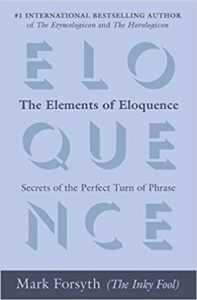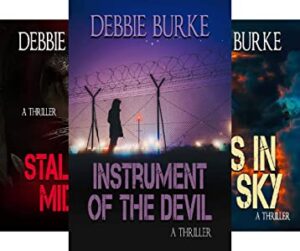By Debbie Burke
When we first learned to talk, most likely we never gave a second thought to the order of words. We just mimicked our parents until the sentences that came out of our mouths made sense and were understandable.
If a five-year-old said, I kicked over the fence the ball, most likely Mom, Dad, or a kindergarten teacher would tell the child it sounded better to say: I kicked the ball over the fence.
We instinctively knew how to place the words in the right order, even though we didn’t realize exactly what it was we knew or how we knew it.
 [Side note: English is a particularly difficult language for non-native speakers to learn because it’s full of inconsistencies and contradictory rules. If you didn’t learn English as a first language, please accept my condolences for the misery you’re going through.]
[Side note: English is a particularly difficult language for non-native speakers to learn because it’s full of inconsistencies and contradictory rules. If you didn’t learn English as a first language, please accept my condolences for the misery you’re going through.]
At some point in our language development, we learned that adjectives make sentences more descriptive. For those of us destined to become writers, adjectives became fun new toys.

Consider the three examples below:
The Jack Russell tan frisky terrier chased a mouse.
Hey, wait a sec. That sounds awkward. What’s wrong?
Instead, how about:
The frisky tan Jack Russell terrier chased a mouse.
Sounds natural.
A hot-air red massive balloon floated above farm land.
Awkward.
A massive red hot-air balloon floated above farm land.
Natural.
A new silver shiny Cadillac was parked in the murky dark shadows of the concrete parking high-rise garage.
Awkward.
A shiny new silver Cadillac was parked in the dark murky shadows of the high-rise concrete parking garage.
Natural.
In these examples, one flows easily off the tongue while, in the other, words come out in halts and jerks.
What is the difference?
The order of the adjectives.
Huh? Who even thinks about that?
Writers, that’s who.
Turns out there are actual rules about the correct order of adjectives.
 Recently I learned that new lesson when TKZ regular Chuck sent me an interesting article that quotes The Elements of Eloquence: Secrets of the Perfect Turn of Phrase by Mark Forsyth. In his book, Forsyth separates adjectives into eight different types of descriptors and their proper order:
Recently I learned that new lesson when TKZ regular Chuck sent me an interesting article that quotes The Elements of Eloquence: Secrets of the Perfect Turn of Phrase by Mark Forsyth. In his book, Forsyth separates adjectives into eight different types of descriptors and their proper order:
- Opinion
- Size
- Age
- Shape
- Color
- Origin
- Material
- Purpose
There is even a handy little acronym to remind you of the correct order, using the first letter of each type: OSASCOMP.
Cambridge Dictionary doesn’t want the rules to be that simple so they offer an alternate option that divides adjectives into 10 classifications in slightly different order.
- Opinion
- Size
- Physical quality
- Shape
- Age
- Color
- Origin
- Material
- Type
- Purpose
Translated to an acronym: OSPSACOMTP.
Hmm, I think I’ll stick with Forsyth’s version.
In Elements of Eloquence, Forsyth illustrates the correct order with this complicated yet coherent phrase:
A lovely little old rectangular green French silver whittling knife.
Take a moment to experiment. Can you rearrange the adjectives in a different order that makes sense and sounds better?
Me neither.
Of course, no author would dare string that many adjectives together without a stern reprimand from the editor.

Photo credit: Isaak Alexandre Karslain, Unsplash
Let’s have some fun with a quiz. Read the following jumbled descriptions and put them in the correct order. Your choice of either Forsyth’s or Cambridge Dictionary’s rules.
- The wicked old shriveled witch cast a permanent vengeful curse on the young innocent maiden.
- The black-and-tan huge guard German Shepherd dog growled when the child grabbed her puppy.
- The parchment ancient yellowed fragile scroll crumbled when touched.
- Margie couldn’t resist buying the silk designer black sexy strapless dress.
Below are my answers. If you disagree, please share in the comment section.
- The wicked (opinion) shriveled (physical quality) old (age) witch cast a vengeful (opinion) permanent (type) curse on the innocent (opinion) young (age) maiden.
- The huge (size) black-and-tan (color) German Shepherd (origin) guard (purpose) dog growled when the child grabbed her puppy.
- The fragile (physical quality) ancient (age) yellowed (color) parchment (material) scroll crumbled when touched.
- Margie couldn’t resist buying the sexy (opinion) strapless (shape) black (color) designer (origin) silk (material) dress.
Here’s a shortcut for when you’re writing a sentence with several adjectives but can’t remember the rules:
Read the sentence out loud.
If it sounds awkward, rearrange the order of the adjectives until the sentence flows smoothly and naturally.
If you’re still not sure, read the sentence out loud to someone else. Ask how the adjective order sounds best to their ears.
If you can’t remember the rules or would rather ignore them, here’s the easiest option of all: don’t string more than two adjectives together.
Your editor will appreciate it and so will your readers.
~~~
TKZers: Did you know there were rules for the order of adjectives?
As a writer, do you love adjectives? Or would you rather discard them in the same wastebasket with adverbs?
~~~
Debbie Burke is an absentminded (opinion) aging (age) blond (color) Montana (origin) thriller (purpose) writer who never uses more than two adjectives in a row. You can verify that if you read Debbie’s six-book series at this link.

